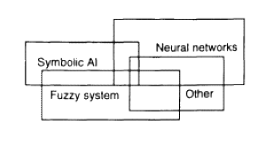SKEDSOFT
Each of the paradigms has a contribution to make to the ultimate solution of a problem, as is pointed out below:
Symbolic AI systems can contribute with:
- Rigid theory for symbol manipulation; theorem proving
- Rigorous exact reasoning mechanisms, including chain reasoning and different reasoning strategies
- Universal computational models (e.g., the production systems)
Fuzzy systems can contribute with:
- Well-developed fuzzy logic theory
- Humanlike reasoning mechanisms; using linguistic terms
- Accommodating commonsense knowledge, ambiguous knowledge, imprecise but rational knowledge
- Universal approximation techniques
- Robustness, fault tolerance
- Low cost of development and maintenance
- Low computational cost
Neural networks can contribute with:
- Learning from data
- Modeling empirical behavior of humans
- Universal approximation techniques
- Good generalization
- Methods for extracting knowledge from data
- Methods for data analysis
- Associative memories and pattern-matching techniques
- Massive parallelism
- Robustness
These three groups of methods as complementary for three reasons:

(1) They facilitatedealing with different kinds of knowledge representation, different inference, different accuracy andfault tolerance, etc.
(2) Each of them may be superior to the others when solving a concrete subtask of aproblem; for example, the symbolic approach and the connectionist approach have demonstratedstrengths in solving different tasks. The former has been successful in high-levelcognitive tasks, whereas the latter is more successful in low-level perceptual and learning tasks.
(3) One method may beapplied to improve the performance of another.